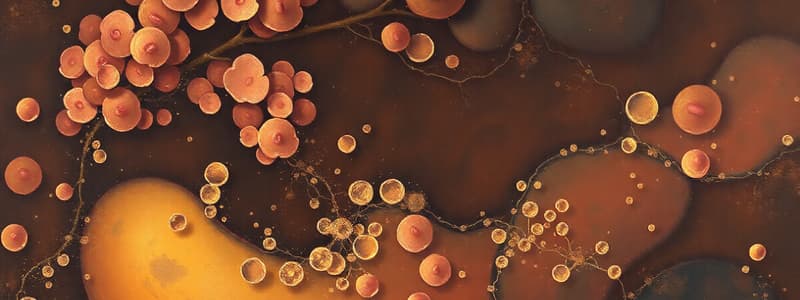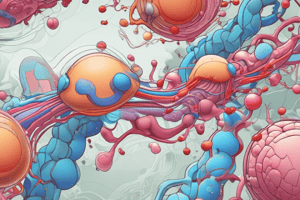Podcast
Questions and Answers
What are triacylglycerols primarily composed of?
What are triacylglycerols primarily composed of?
- A glycerol backbone and 4 fatty acids
- A glycerol backbone and 2 fatty acids
- A glycerol backbone and 3 fatty acids (correct)
- A sphingosine backbone and 3 fatty acids
Which is a characteristic of oils in relation to triacylglycerols?
Which is a characteristic of oils in relation to triacylglycerols?
- They contain both saturated and unsaturated fatty acids.
- They cannot be used for hydrogenation.
- They are solid due to high saturated fatty acids.
- They are liquid due to high unsaturated fatty acids. (correct)
What is the primary difference between phosphoglycerides and sphingomyelin?
What is the primary difference between phosphoglycerides and sphingomyelin?
- Phosphoglycerides have no fatty acids, while sphingomyelin does.
- Phosphoglycerides contain glycerol, while sphingomyelin contains sphingosine. (correct)
- Phosphoglycerides are solid, while sphingomyelin is liquid.
- Phosphoglycerides contain sphingosine, while sphingomyelin contains glycerol.
How do phospholipids primarily function in biological systems?
How do phospholipids primarily function in biological systems?
What role do lysophospholipids play when formed from lecithin?
What role do lysophospholipids play when formed from lecithin?
What types of fatty acids are primarily found in solid fats?
What types of fatty acids are primarily found in solid fats?
What is the effect of the enzyme lecithinase found in snake venom?
What is the effect of the enzyme lecithinase found in snake venom?
Which class of lipids do phospholipids belong to?
Which class of lipids do phospholipids belong to?
What do phospholipids form when mixed with water?
What do phospholipids form when mixed with water?
What is the process called that converts oils into solid fats?
What is the process called that converts oils into solid fats?
Flashcards
Triacylglycerol (TAG)
Triacylglycerol (TAG)
A simple lipid composed of a glycerol backbone with three fatty acids attached.
Simple Lipids
Simple Lipids
Lipids composed only of carbon, hydrogen and oxygen.
Oils
Oils
Liquid fats with a high content of unsaturated fatty acids (USFA).
Fats
Fats
Signup and view all the flashcards
Hardening
Hardening
Signup and view all the flashcards
Phospholipids
Phospholipids
Signup and view all the flashcards
Phosphoglycerides
Phosphoglycerides
Signup and view all the flashcards
Sphingomyelin
Sphingomyelin
Signup and view all the flashcards
Lysophospholipids
Lysophospholipids
Signup and view all the flashcards
Amphipathic
Amphipathic
Signup and view all the flashcards
Study Notes
Triacylglycerol (TAG)
- Triacylglycerols (TAGs) are neutral fats, a type of simple lipid.
- TAGs consist of a glycerol backbone with three fatty acids attached.
- Glycerol backbone has a chemical structure CH₂OH-CHOH-CH₂OH
TAG Classification
- TAGs are categorized into oils and fats.
- Oils are liquid at room temperature due to high unsaturated fatty acid (USFA) content. Examples include corn oil, cottonseed oil, and soybean oil.
- Fats are solid at room temperature with a high saturated fatty acid (SFA) content. Examples include margarine.
Hardening of Oils
- Hardening is the hydrogenation of oils to create solid fats like margarine. This process converts unsaturated fatty acids to saturated fatty acids.
Phospholipids
- Phospholipids are compound lipids.
- Classification is based on the alcohol present.
- Phosphoglycerides contain glycerol.
- Sphingomyelin contains sphingosine.
Phosphoglycerides
- Phosphatidic acid
- Lecithin (phosphatidylcholine)
- Cephalin (phosphatidylethanolamine)
- Phosphatidylserine
- Phosphatidylinositol
Sphingomyelin
- Sphingomyelin differs from other phospholipids by containing sphingosine instead of glycerol.
Ceramide Structure
- Ceramide is a component of sphingomyelin.
- It consists of sphingosine and a fatty acid.
Phospholipid Importance
- Amphipathic molecules (both polar and nonpolar parts).
- Form micelles in water.
- Good emulsifying agents aiding in fat digestion.
- Essential constituents of cell membranes.
- Components of plasma lipoproteins (lipid carriers in the blood).
Lysophospholipids
- Formed by the action of phospholipase A2 on lecithin or cephalin.
- Phospholipase A2 removes a fatty acid from position 2.
Snake Venom
- Contains lecithinase enzymes.
- When injected into blood converts phospholipids in red blood cell membranes into lysophospholipids.
- Leads to red blood cell lysis and potential death if not treated.
Steroids
- Steroids are categorized into sterols, bile acids, and steroid hormones.
- Sterols include cholesterol.
- Bile acids aid in fat digestion and absorption.
- Steroid hormones include glucocorticoids, mineralocorticoids, and sex hormones.
Bile Acids
- Primary bile acids are synthesized from cholesterol in the liver.
- Secondary bile acids are formed by intestinal bacteria acting on primary bile acids.
- Bile acids are conjugated with glycine or taurine, and sodium; then secreted as bile salts.
Bile Salts Function
- Bile salts are important for emulsifying fats.
- This aids in the digestion and absorption of fats.
Studying That Suits You
Use AI to generate personalized quizzes and flashcards to suit your learning preferences.
Related Documents
Description
This quiz covers the fundamentals of triacylglycerols (TAGs) and their classification into oils and fats. It also explores the hydrogenation process of oils, leading to the formation of solid fats like margarine, and delves into phospholipids and their types, such as phosphoglycerides. Test your knowledge on these key concepts in lipid chemistry!




